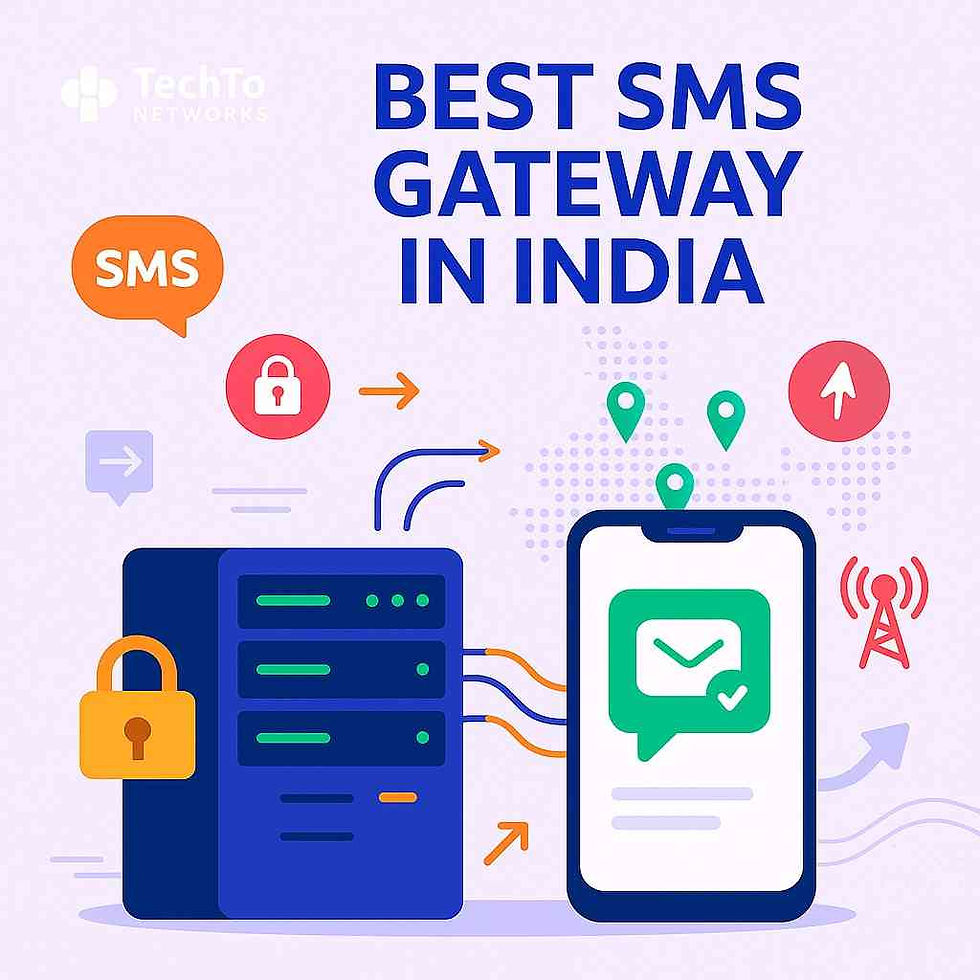Transactional Message: The Backbone of Real-Time Communication
- techtonetworks
- 6 days ago
- 4 min read
In the modern digital ecosystem, businesses thrive on real-time, reliable, and relevant communication. Whether it's delivering a one-time password (OTP) for login, sending a bank transaction alert, or confirming an order—transactional messages are the silent workhorses behind seamless customer experience. They ensure trust, security, and responsiveness, and have become indispensable across industries.
Let’s explore what a transactional message really is, how it functions technically, and why it should be a top priority in your business communication strategy.
What Is a Transactional Message?
A transactional message is a type of automated message triggered by a specific user action or system event. These messages are strictly informational and not promotional. Their core purpose is to deliver critical, time-sensitive information that enhances the user experience and builds trust.
Key Characteristics of Transactional Messages
User-initiated: Triggered by a customer action (e.g., login, purchase).
Time-sensitive: Delivered instantly with high priority.
Non-promotional: Purely informative, not meant for marketing.
Examples include OTPs, payment receipts, shipping updates, and account alerts.
Types of Transactional Messages Used in Business
OTPs and 2FA Notifications
Two-factor authentication messages for:
Login verification
Password resets
Secure data access
Payment Confirmations and Order Updates
Used by e-commerce, banking, and fintech platforms to notify:
Successful purchases
Invoice generation
Delivery progress
System Alerts and Security Notifications
Real-time alerts for:
Unauthorized access
System outages
Data breach warnings
How Transactional Messages Work Technically
Behind every transactional message lies a robust infrastructure involving APIs, routing, and real-time monitoring.
Message Queues and Triggers
Event-based triggers initiate message dispatch.
Microservices or CRON jobs queue the payload.
Delivery Routing via SMS Gateways
Routed via operator-approved transactional SMS channels.
Delivered even to DND-registered numbers.
Monitoring, Reporting, and Feedback Loops
Delivery status (DLR) and failure reasons tracked.
Webhooks and callbacks notify the source system.
Benefits of Implementing a Transactional Messaging System
Instant Communication with Customers
Builds trust and transparency with up-to-date information on their actions or transactions.
Improved Security and Fraud Prevention
Protects accounts with 2FA and transaction alerts, reducing data breach risks.
Reduced Operational Load
Minimizes manual support requests like “Where’s my order?” or “Was my payment successful?”
Transactional Message vs Promotional Message
Feature | Transactional Message | Promotional Message |
Purpose | Informational | Marketing |
Delivery to DND Numbers | Yes | No |
Approval Required | Template only | Template + Timing |
User Action Based | Yes | No |
Transactional messages are prioritized and bypass telecom marketing filters, while promotional ones are often delayed or blocked.
Key Platforms Offering Transactional Message APIs
High TPS handling
REST API with SDKs
Real-time analytics and DLT support
Twilio
Global reach with SMS fallback
Programmable messaging flows
MSG91
India-centric DLT integration
Strong reporting capabilities
Compliance and Data Privacy in Transactional Messaging
TRAI DLT Rules in India
Sender ID and template registration
Consent and content regulation
TechTo Networks offers in-platform compliance automation
GDPR and Consent Policies
Explicit opt-in required
Data protection protocols like anonymization and encryption enforced
Building a Transactional Messaging Workflow
System Triggers and Automation Logic
Use tools like Zapier, custom scripts, or internal services to detect user actions and initiate messaging.
Failover and Retry Mechanisms
Smart retry engines ensure delivery even during operator downtimes.
Template Management and Approval
DLT-compliant templates pre-approved by telecom operators are used dynamically.
Real-World Examples of Transactional Messaging
E-commerce Checkout Notifications
Amazon, Flipkart, etc., send instant payment confirmations and shipping details.
Banking Transaction Alerts
ICICI, HDFC, and neobanks use SMS for:
Debit/Credit updates
Suspicious activity alerts
Health Appointment Reminders
Healthcare apps and hospitals send:
Appointment confirmations
Follow-up reminders
Common Challenges in Transactional Messaging
Message Delays or Failures
Caused by poor routing, server overload, or invalid numbers.
Spam Filtering and Blacklisting
Improperly configured sender IDs or templates may be flagged.
Compliance Violations
Non-registered templates or DND violations can result in heavy penalties.
Future Trends in Transactional Messaging
AI-based Personalization
Dynamic content based on user context and history for improved engagement.
Multi-channel Sync (SMS + Email + WhatsApp)
Coordinated messages across platforms with fallback logic.
FAQs About Transactional Messages
1. Are transactional messages exempt from DND restrictions?
Yes, they bypass DND filters since they’re user-initiated.
2. How fast are transactional messages delivered?
Typically within 1–5 seconds via direct operator routes.
3. Can I customize transactional templates?
Yes, but they must be pre-approved and include mandatory variables.
4. Do I need a separate system for transactional and promotional messages?
Yes, due to different routing, regulations, and use cases.
5. Are transactional messages encrypted?
Yes, most platforms like TechTo Networks encrypt data in transit and at rest.
6. Can I track delivery status in real time?
Absolutely—platforms provide dashboards and webhooks for real-time DLRs.
Conclusion: Why Every Business Needs a Reliable Transactional Message System
In a landscape where customer trust and instant updates are mission-critical, the transactional message has become an indispensable tool. From safeguarding logins to confirming orders and notifying users of important system events, transactional messaging keeps businesses connected, secure, and compliant.
By leveraging powerful platforms like TechTo Networks, businesses can ensure fast, secure, and scalable transactional communication—building better customer relationships and operational excellence.




Comments